length TOYOTA CAMRY 2020 Warranties & Maintenance Guides (in English)
[x] Cancel search | Manufacturer: TOYOTA, Model Year: 2020, Model line: CAMRY, Model: TOYOTA CAMRY 2020Pages: 260, PDF Size: 8.54 MB
Page 8 of 260
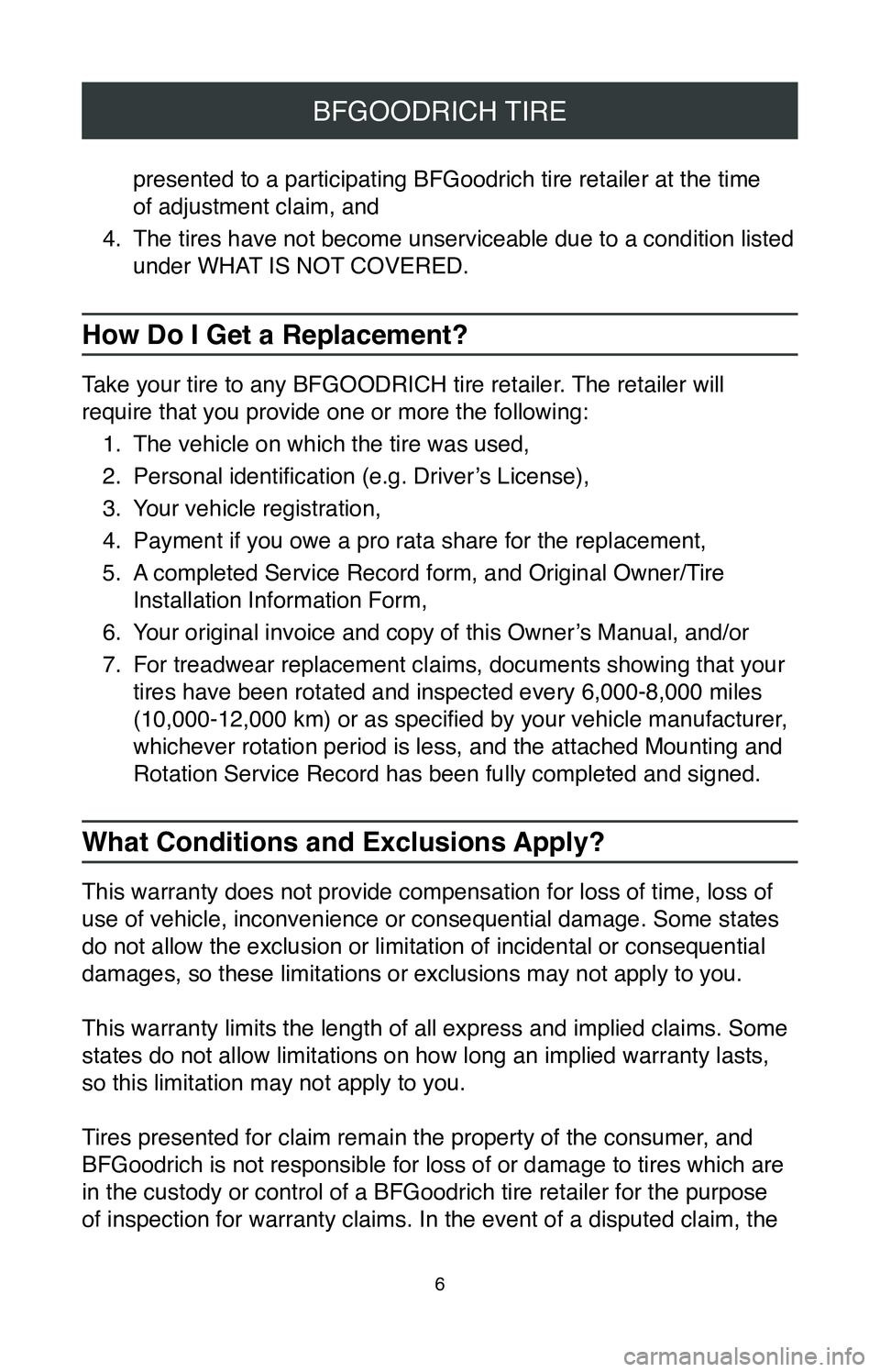
6
BFGOODRICH TIRE
presented to a participating BFGoodrich tire retailer at the time
of adjustment claim, and
4.
The tires have not become unserviceable due to a condition listed
under WHAT IS NOT COVERED.
How Do I Get a Replacement?
Take your tire to any BFGOODRICH tire retailer. The retailer will
require that you provide one or more the following: 1.
The vehicle on which the tire was used,
2.
Personal identification (e.g. Driver’s License),
3.
Your vehicle registration,
4.
Payment if you owe a pro rata share for the replacement,
5.
A completed Service Record form, and Original Owner/Tire
Installation Information Form,
6.
Your original invoice and copy of this Owner’s Manual, and/or
7.
For treadwear replacement claims, documents showing that your
tires have been rotated and inspected every 6,000-8,000 miles
(10,000-12,000 km) or as specified by your vehicle manufacturer,
whichever rotation period is less, and the attached Mounting and
Rotation Service Record has been fully completed and signed.
What Conditions and Exclusions Apply?
This warranty does not provide compensation for loss of time, loss of
use of vehicle, inconvenience or consequential damage. Some states
do not allow the exclusion or limitation of incidental or consequential \
damages, so these limitations or exclusions may not apply to you.
This warranty limits the length of all express and implied claims. Some \
states do not allow limitations on how long an implied warranty lasts,
so this limitation may not apply to you.
Tires presented for claim remain the property of the consumer, and
BFGoodrich is not responsible for loss of or damage to tires which are
in the custody or control of a BFGoodrich tire retailer for the purpose \
of inspection for warranty claims. In the event of a disputed claim, the\
Page 122 of 260
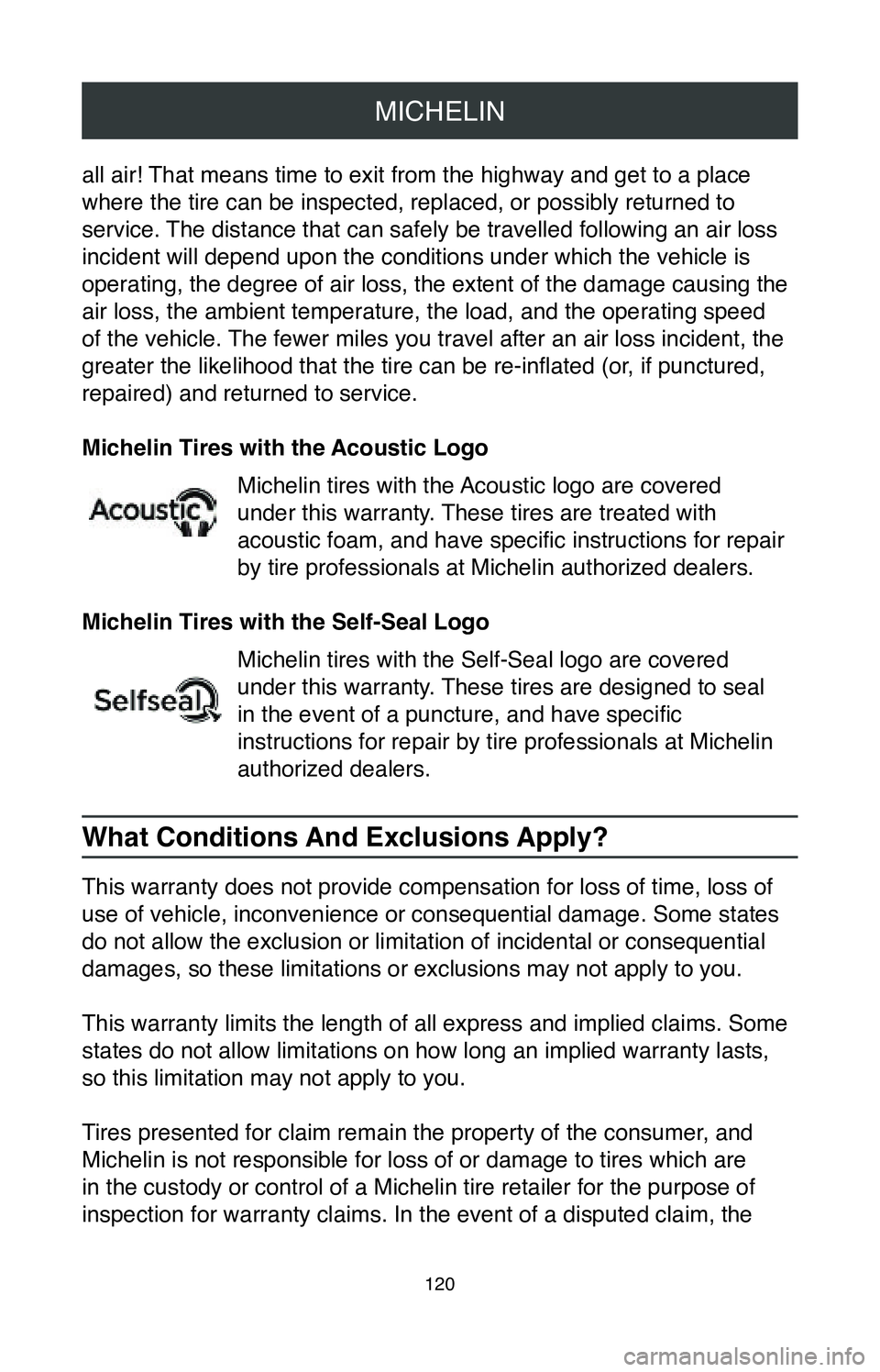
MICHELIN
120
all air! That means time to exit from the highway and get to a place
where the tire can be inspected, replaced, or possibly returned to
service. The distance that can safely be travelled following an air loss
incident will depend upon the conditions under which the vehicle is
operating, the degree of air loss, the extent of the damage causing the \
air loss, the ambient temperature, the load, and the operating speed
of the vehicle. The fewer miles you travel after an air loss incident, the
greater the likelihood that the tire can be re-inflated (or, if punctured,
repaired) and returned to service.
Michelin Tires with the Acoustic Logo Michelin tires with the Acoustic logo are covered
under this warranty. These tires are treated with
acoustic foam, and have specific instructions for repair
by tire professionals at Michelin authorized dealers.
Michelin Tires with the Self-Seal Logo
Michelin tires with the Self-Seal logo are covered
under this warranty. These tires are designed to seal
in the event of a puncture, and have specific
instructions for repair by tire professionals at Michelin
authorized dealers.
What Conditions And Exclusions Apply?
This warranty does not provide compensation for loss of time, loss of
use of vehicle, inconvenience or consequential damage. Some states
do not allow the exclusion or limitation of incidental or consequential \
damages, so these limitations or exclusions may not apply to you.
This warranty limits the length of all express and implied claims. Some \
states do not allow limitations on how long an implied warranty lasts,
so this limitation may not apply to you.
Tires presented for claim remain the property of the consumer, and
Michelin is not responsible for loss of or damage to tires which are
in the custody or control of a Michelin tire retailer for the purpose of\
inspection for warranty claims. In the event of a disputed claim, the
Page 127 of 260
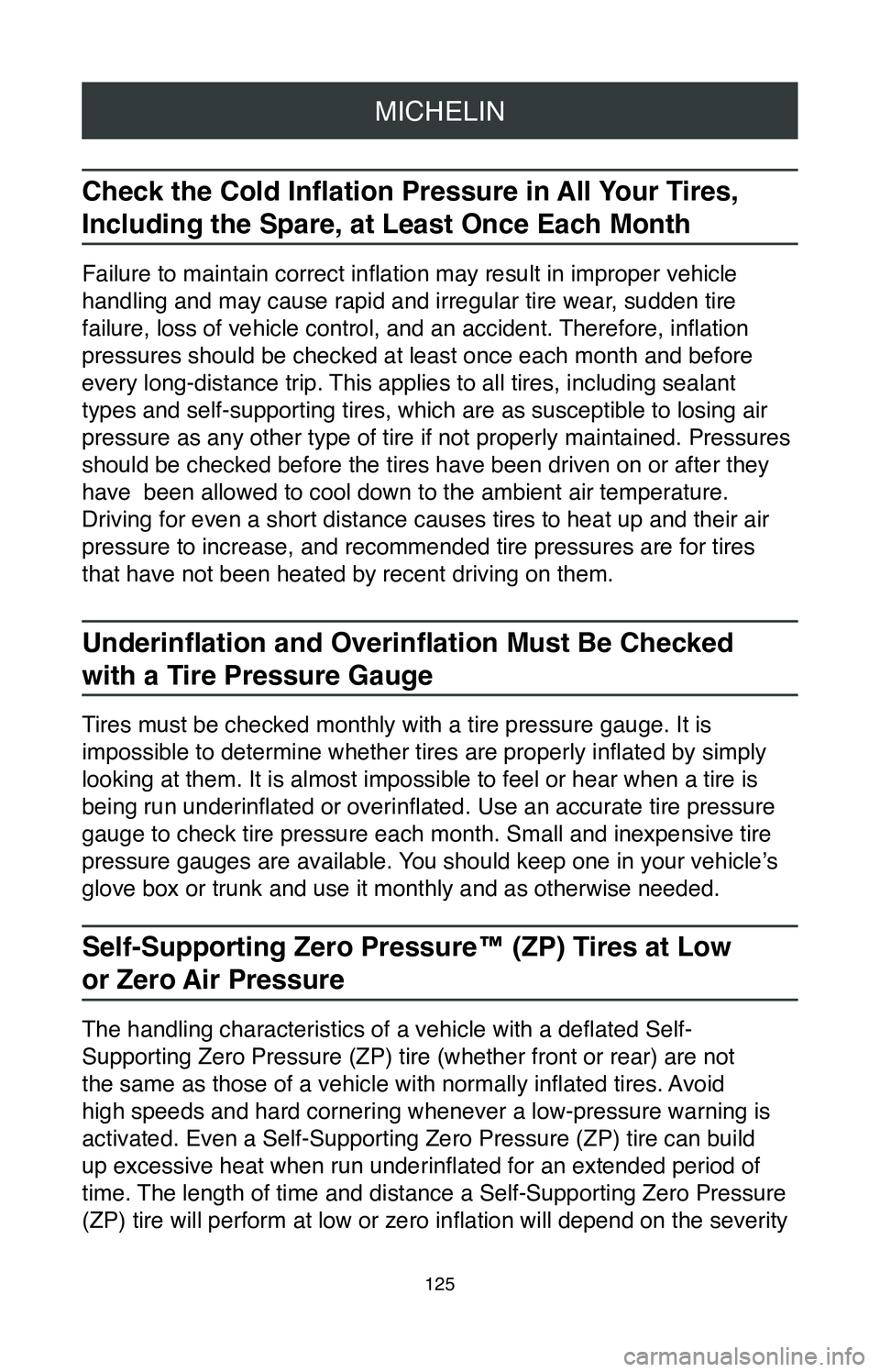
MICHELIN
125
Check the Cold Inflation Pressure in All Your Tires,
Including the Spare, at Least Once Each Month
Failure to maintain correct inflation may result in improper vehicle
handling and may cause rapid and irregular tire wear, sudden tire
failure, loss of vehicle control, and an accident. Therefore, inflation
pressures should be checked at least once each month and before
every long-distance trip. This applies to all tires, including sealant
types and self-supporting tires, which are as susceptible to losing air
pressure as any other type of tire if not properly maintained. Pressures\
should be checked before the tires have been driven on or after they
have been allowed to cool down to the ambient air temperature.
Driving for even a short distance causes tires to heat up and their air \
pressure to increase, and recommended tire pressures are for tires
that have not been heated by recent driving on them.
Underinflation and Overinflation Must Be Checked
with a Tire Pressure Gauge
Tires must be checked monthly with a tire pressure gauge. It is
impossible to determine whether tires are properly inflated by simply
looking at them. It is almost impossible to feel or hear when a tire is \
being run underinflated or overinflated. Use an accurate tire pressure
gauge to check tire pressure each month. Small and inexpensive tire
pressure gauges are available. You should keep one in your vehicle’s
glove box or trunk and use it monthly and as otherwise needed.
Self-Supporting Zero Pressure™ (ZP) Tires at Low
or Zero Air Pressure
The handling characteristics of a vehicle with a deflated Self-
Supporting Zero Pressure (ZP) tire (whether front or rear) are not
the same as those of a vehicle with normally inflated tires. Avoid
high speeds and hard cornering whenever a low-pressure warning is
activated. Even a Self-Supporting Zero Pressure (ZP) tire can build
up excessive heat when run underinflated for an extended period of
time. The length of time and distance a Self-Supporting Zero Pressure
(ZP) tire will perform at low or zero inflation will depend on the severity
Page 128 of 260
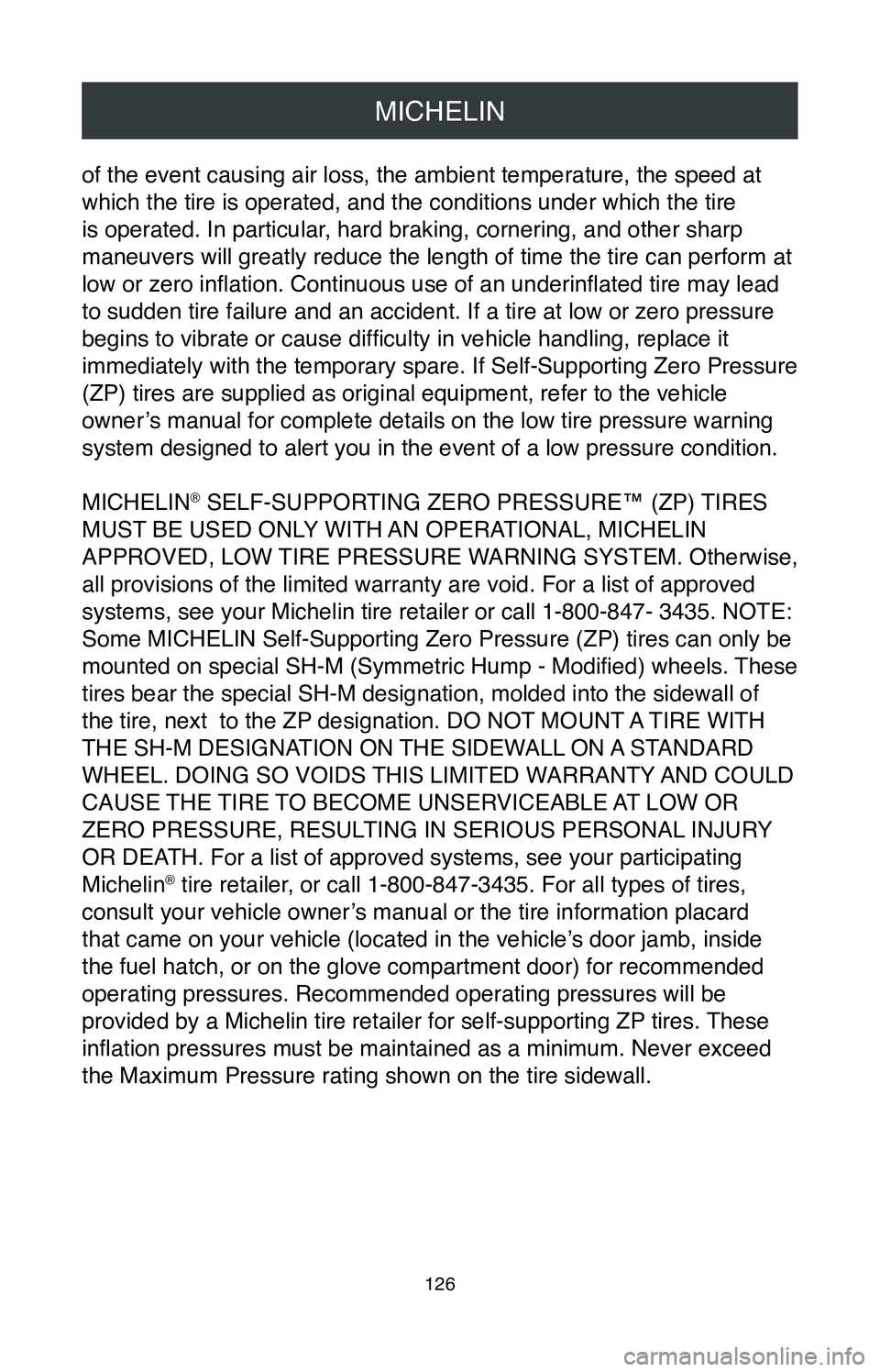
MICHELIN
126
of the event causing air loss, the ambient temperature, the speed at
which the tire is operated, and the conditions under which the tire
is operated. In particular, hard braking, cornering, and other sharp
maneuvers will greatly reduce the length of time the tire can perform at\
low or zero inflation. Continuous use of an underinflated tire may lead
to sudden tire failure and an accident. If a tire at low or zero pressur\
e
begins to vibrate or cause difficulty in vehicle handling, replace it
immediately with the temporary spare. If Self-Supporting Zero Pressure
(ZP) tires are supplied as original equipment, refer to the vehicle
owner’s manual for complete details on the low tire pressure warning
system designed to alert you in the event of a low pressure condition.
MICHELIN
® SELF-SUPPORTING ZERO PRESSURE™ (ZP) TIRES
MUST BE USED ONLY WITH AN OPERATIONAL, MICHELIN
APPROVED, LOW TIRE PRESSURE WARNING SYSTEM. Otherwise,
all provisions of the limited warranty are void. For a list of approved \
systems, see your Michelin tire retailer or call 1-800-847- 3435. NOTE:
Some MICHELIN Self-Supporting Zero Pressure (ZP) tires can only be
mounted on special SH-M (Symmetric Hump - Modified) wheels. These
tires bear the special SH-M designation, molded into the sidewall of
the tire, next to the ZP designation. DO NOT MOUNT A TIRE WITH
THE SH-M DESIGNATION ON THE SIDEWALL ON A STANDARD
WHEEL. DOING SO VOIDS THIS LIMITED WARRANTY AND COULD
CAUSE THE TIRE TO BECOME UNSERVICEABLE AT LOW OR
ZERO PRESSURE, RESULTING IN SERIOUS PERSONAL INJURY
OR DEATH. For a list of approved systems, see your participating
Michelin
® tire retailer, or call 1-800-847-3435. For all types of tires,
consult your vehicle owner’s manual or the tire information placard
that came on your vehicle (located in the vehicle’s door jamb, inside
the fuel hatch, or on the glove compartment door) for recommended
operating pressures. Recommended operating pressures will be
provided by a Michelin tire retailer for self-supporting ZP tires. These
inflation pressures must be maintained as a minimum. Never exceed
the Maximum Pressure rating shown on the tire sidewall.
Page 254 of 260
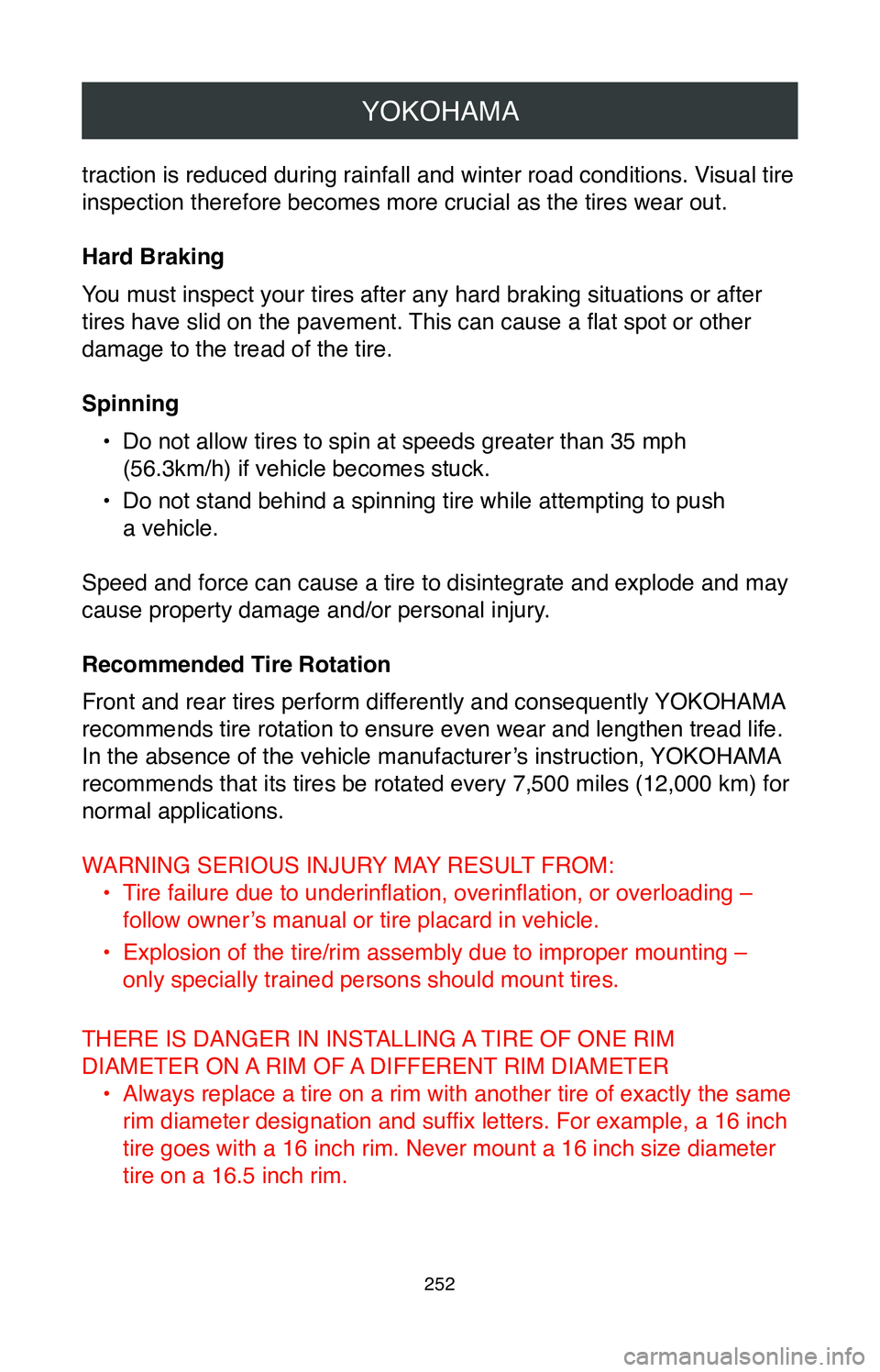
YOKOHAMA
252
traction is reduced during rainfall and winter road conditions. Visual tire
inspection therefore becomes more crucial as the tires wear out.
Hard Braking
You must inspect your tires after any hard braking situations or after
tires have slid on the pavement. This can cause a flat spot or other
damage to the tread of the tire.
Spinning•
Do not allow tires to spin at speeds greater than 35 mph
(56.3km/h) if vehicle becomes stuck.
•
Do not stand behind a spinning tire while attempting to push
a vehicle.
Speed and force can cause a tire to disintegrate and explode and may
cause property damage and/or personal injury.
Recommended Tire Rotation
Front and rear tires perform differently and consequently YOKOHAMA
recommends tire rotation to ensure even wear and lengthen tread life.
In the absence of the vehicle manufacturer’s instruction, YOKOHAMA
recommends that its tires be rotated every 7,500 miles (12,000 km) for
normal applications.
WARNING SERIOUS INJURY MAY RESULT FROM: •
Tire failure due to underinflation, overinflation, or overloading –
follow owner’s manual or tire placard in vehicle.
•
Explosion of the tire/rim assembly due to improper mounting –
only specially trained persons should mount tires.
THERE IS DANGER IN INSTALLING A TIRE OF ONE RIM
DIAMETER ON A RIM OF A DIFFERENT RIM DIAMETER •
Always replace a tire on a rim with another tire of exactly the same
rim diameter designation and suffix letters. For example, a 16 inch
tire goes with a 16 inch rim. Never mount a 16 inch size diameter
tire on a 16.5 inch rim.